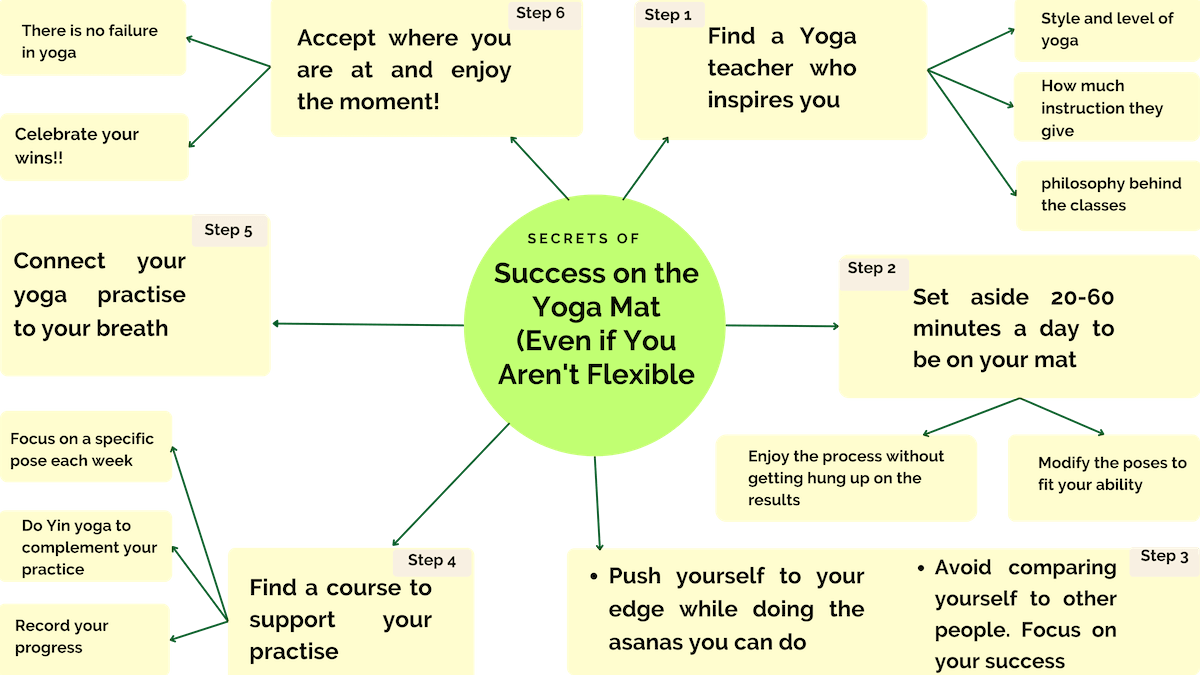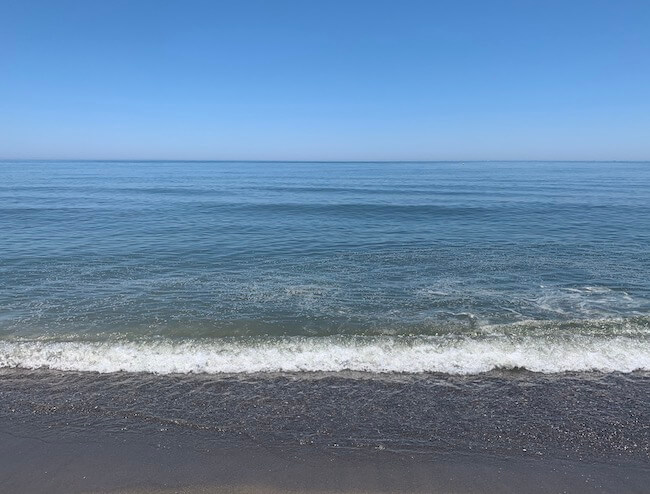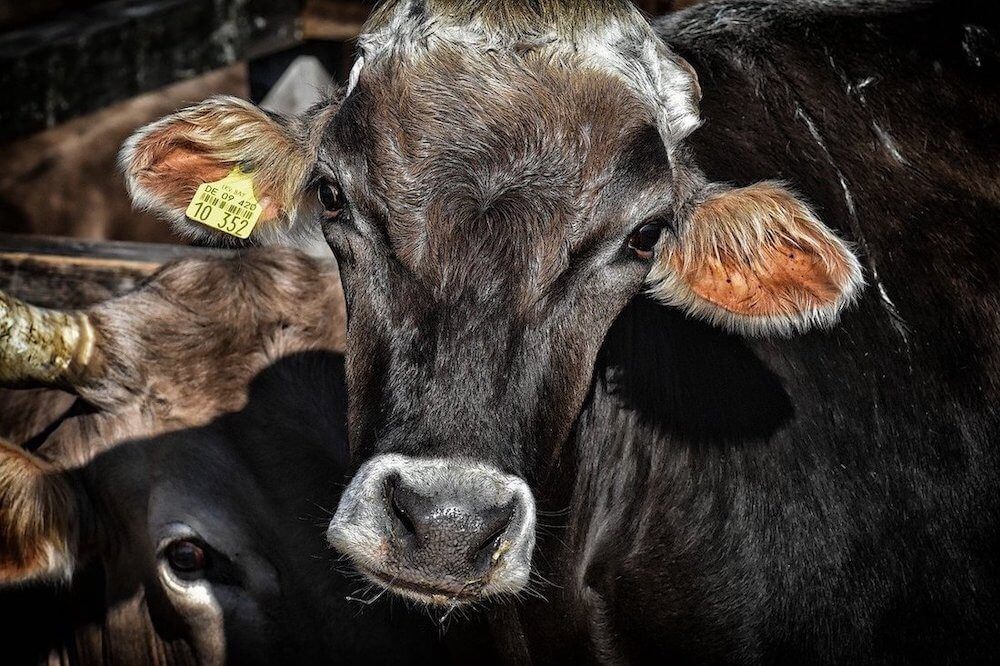Can you do yoga if you’re not flexible? You bet you can!
Some of the best yogis started out as flexible as a steel rod! It’s true! Flexibility isn’t a prerequisite for yoga.
I get it – you suspect that because you’re not flexible, you’ll never be able to do yoga.
When you drop something to the floor, you bend your knees and scoop it up awkwardly into your hands. Right?
Because there’s no point bending over if you know you can’t reach the floor.
Or maybe you can reach the ground, but your hips are tight and you can’t sit cross-legged.
Or perhaps it’s your shoulders that are stiff . . or whatever goal-post you use to judge flexibility.
You think flexibility is for other people.
A long-lost memory from childhood.
And when you see someone do yoga, you know for a fact that they must be from a different planet, made of rubber and built differently to you.
And I get it because I was the same.
But don’t let the belief that you need to be naturally flexible stop you from doing yoga.
Because you can do it!
And in this post, I’m going to show you exactly how you can do yoga regardless of your current flexibility.
So without further ado, let’s take a look at the role of flexibility in yoga.
Photo by Dane Wetton on Unsplash
Table of Contents
- Quick Overview: Can You Do Yoga if You Aren’t Flexible?
- Is Flexibility Important for Yoga?
- The Truth About Yoga Practice
- Incredible Yoga Transformation
- How do I Start Yoga if I’m Not Flexible?
- How Long does it Take to Get Flexible with Yoga?
- Why Aren’t I Getting More Flexible with Yoga?
- Conclusion on Practising Yoga if You Aren’t Flexible
Quick Overview: Can You Do Yoga if You Aren’t Flexible?
- Most people think they can’t do yoga if they aren’t flexible but it isn’t true. Yoga’s a perfect tool for anyone with flexibility issues as it will greatly enhance their flexibility and range of movement.
- Rather than expecting to be flexible before starting yoga, we should do yoga with the intention of becoming more flexible.
- Start of with some of the easier poses and build up from there.
- Adapt poses to suit your level of fitness and flexibility.
- As you progress, so will your yoga practice and ultimately, your flexibility.
Is Flexibility Important for Yoga?
People say ‘I am flexible’, or ‘I’m not flexible’ (and you can sub the word flexible for almost any other adjective), as though it were some kind of permanent attribute.
But it isn’t.
We become inflexible through our sedentary (or non-flexible) lifestyle.
And just as we become inflexible, we can get more flexible.
Sure, it takes time. Sure, it takes effort. And it’s true, you may not get to be as flexible as you were when you were 8 years old ever again.
But it happens.
Yoga Asanas and Flexibility
First of all, yoga isn’t only about the physical asanas (poses). But for the purposes of this article, we can discuss just the physical aspect of practising yoga and leave the life lessons from yoga for another article.
Ok I lied, we’ll leave most of it for another article, but not all of it!
Because this post wouldn’t be complete if it didn’t include a bit about the mindset to begin with.
Let’s get the elephant out of the room. Everybody can do yoga.
But not everybody can do every type of yoga and not everybody can do every pose in yoga.
But once you accept that, you realise you’re actually in exactly the same position as every other person who ever stepped on a yoga mat as a beginner or elementary student.
There you are, at your starting point. Some poses are beyond your reach and others aren’t. You will have to start wherever you are.
And that’s just the point. Nobody starts yoga as an expert. We have to practise before we get to progress, and we all remain students forever.
And it’s the yoga practice, over time, which brings us increased flexibility. Not the other way around. No matter where you are, yoga can only take you one step from where you are.
And if you’ve hit a plateau and don’t feel like you’re progressing in your yoga practice, just know that we can all progress in yoga even if we have a home practice.
We just need to have the right mindset and guidance for our practice.
The Truth About Yoga Practice
We all have something in common no matter where we are in our practice – we are all challenging ourselves to the edge of our ability (I like to call it our ‘line’).
and not being able to do a whole bunch of poses, but focusing on the ones which we can do, and pushing ourselves in those.
The most important thing to remember when starting out on the yoga mat is that it doesn’t matter how flexible you are; it only matters that you focus on your own personal ‘line’ and take yourself forward tiny step by tiny step.
So if you start with 3 poses, so be it!
Poses like mountain pose, child’s pose, downward facing dog, warrior one, triangle pose and forward bend, for example, are all beginner-friendly poses.
And you can really get the same awesome sensations from your session doing these, as long as you work to your line.
With the more challenging poses, you can modify them – by putting your knees on the floor for example when doing plank or Chaturanga.
When I started out, I couldn’t place my hands flat on the floor, yet now that comes easily to me.
And that’s not because I’m talented or anything like that, it’s just that I persevered in the moment (for many years, and more to come!) and I kept on doing the work.
As Nathania Stambouli from Yogi Flight School says:
Be dedicated to the practise without being attached to the outcome.
Nathania Stambouli – YFS
So don’t worry about the results but persevere in your practice and you’ll find that your own personal line (the line where you reach your limit), will shift.
Incredible Yoga Transformation
Transformation doesn’t just happen overnight. It takes years of dedication, but when you fall in love with yoga and accept it for the present moment, then the rest takes care of itself.
Take a look at this awe-inspiring transformation which is the story of Arthur Booman and how he embraced yoga and allowed his yoga practice to transform him.
How do I Start Yoga if I’m Not Flexible?
Anyone can start yoga.
Yoga will help not just your flexibility, but also your mindset and general health.
Maybe because of your limiting belief that you aren’t flexible, you think you’re different to others who are starting yoga. You think it’s going to be harder for you.
But actually, most adults who start yoga come to the mat with some kind of limiting belief to overcome.
For some of us, it’s that we think we’re too heavy, for others we may believe we’re too old to do yoga, and for others, getting on the mat may trigger other insecurities about their shyness or about commitment for example.
One of the most powerful lessons we learn by doing yoga is that there is no comparison to other people.
There is only you and your journey. And it matters not even a teeny amount which actual poses you can and can’t do.
What is important is that you give your very best effort to the poses that you do do. And they will reward you richly.
How to Have Success on the Yoga Mat if You’re Not Flexible

Physical Classes or Online Yoga?
The decision of whether to go to classes or to learn yoga at home is a very personal one.
While many people recommend physical classes because of the guidance and encouragement you’ll get, for some of us that’s not what we’re looking for.
We’re not all the same, and the most important thing is to discover just how wonderful yoga is. So if that means staying at home, I’m all in favour.
And if you prefer going to live classes, that’s great too.
When I started out, I wanted to stay at home. I preferred the privacy and the ability to choose exactly what I did each day. So that’s what I did.
Did it make my journey (in terms of progress) longer? Yes.
But did I love it? Yes.
And who knows, theoretically it may have speeded up my journey, because perhaps if I’d forced myself to go to live classes, I might have become disillusioned with yoga and given up.
I mean who knows, right?
So you must choose the way you prefer. Ideally, do yoga at home and go to classes.
Whatever you choose, the most crucial point in learning yoga (and especially in the beginning) is to find teachers who resonate with and inspire you.
No joke, there are literally thousands of different experiences possible from one yoga class, so if you don’t like one, find another.
You can try reading the reviews or asking friends for recommendations but ultimately, you have to have a lesson to really see if the voice inspires you to keep going.
If you choose to practise yoga at home, I highly recommend checking out my favourite yoga teachers in the post on learning yoga at home.
What Style of Yoga is Best for Me if I’m Not Flexible?
Basically, I want you to fall in love with yoga! And I know that it doesn’t happen just in one or two classes. I also know that you can be put off if you have an experience which doesn’t resonate with you.
So I want you to explore different styles of yoga and various teachers until you’ve tried lots and ended with the ones who inspire you.
Hatha Yoga
Hatha yoga focuses on the poses and tends to be calmer and slower than a Vinyasa flow for example. It’s a great starting point for yoga regardless of your flexibility because it introduces the individual asanas.
Yin Yoga
Yin yoga is a completely different style of yoga than all the others and a great complementary practice to go alongside whichever other style you choose.
Yin yoga involves passive stretching, meaning that you completely relax into the pose, and the poses are typically held for several minutes, helping to stretch and lengthen muscles and connective tissues.
Yin yoga’s perfect for anyone who isn’t flexible, but I’d include some Hatha (or other) as well rather than only yin.
Restorative Yoga
Then there’s Restorative yoga which holds some of the poses for longer and will be a gentle and slow flow and blends a yoga flow with some yin style yoga is the about passive holding of stretches and poses for a few minutes, encouraging more flexibility.
Restorative yoga can be a good way to relax and unwind after a hectic and stressful day.
Vinyasa Yoga
Vinyasa yoga is a style of yoga which joins the poses together in a flow. It is more active than the 3 types of yoga mentioned above.
There’s no reason why you can’t do vinyasa yoga as a non-flexible person as long as you already have an understanding of the individual asanas/poses.
Power Yoga, Hot Yoga and Ashtanga Yoga
It’s probably best to avoid power yoga, hot yoga and Ashtanga yoga in the beginning as they are all more demanding practices for someone who is new to yoga.
And if you aren’t flexible, you’ll be better off focussing on increasing your flexibility before jumping into the most strenuous and difficult versions of yoga.
How Long does it Take to Get Flexible with Yoga?
How long is a piece of string?
Sorry. My apologies, that wasn’t fair, but it’s true – this question doesn’t have just one answer.
Flexibility takes a long time to shift – and the older we are, the more time we need to become more flexible.
But what does happen immediately is that your body will be less stiff.
One day without yoga and you can already feel the difference! So while dramatic change happens over time, subtle change occurs in every practice.
Try to push yourself to your line in every practice and enjoy the moment rather than seeking results.
Why Aren’t I Getting More Flexible with Yoga?
The honest, brutal truth? You may not be getting more flexible for a number of reasons and they aren’t all roses and honey!
- Not activating your body during the poses (except in Yin, which is passive stretching)
- Not being properly aligned in the pose
- Not holding the pose long enough (in those poses where you would hold them)
- Not practising yoga regularly enough
- Not practising for long enough
I know some people may disagree with me, but I do believe the only true way to get more flexible is to practise every day.
Now of course there will be some days when everything goes crazy and you just can’t make it onto the mat. But those days should happen rather than being planned.
Try to make yoga part of every day if you want to really feel the difference.
Conclusion on Practising Yoga if You Aren’t Flexible
Anybody can practise yoga and benefit from it. Just envision yourself on the mat, every day doing your thing.
You can make it your special moment of the day. Some ‘you’ time.
Yoga brings so much to our life, so much more than just physical exercise. It connects us to ourselves again (as in like we used to be as children).
It takes time to see the benefits and it takes time to really get to understand how powerful yoga is, so give it a chance and persevere.
Don’t let fear of inflexibility or failure be the thief of joy!
Check out some amazing free yoga lessons on Youtube and put your doubts to one side. You’ll be so glad you did.
How come you’re still here, haven’t you started your yoga practice yet? ?








